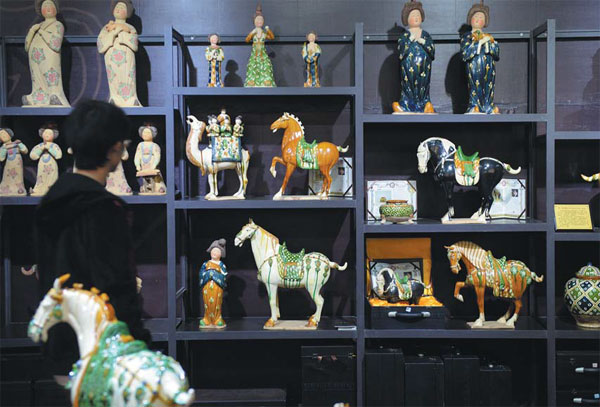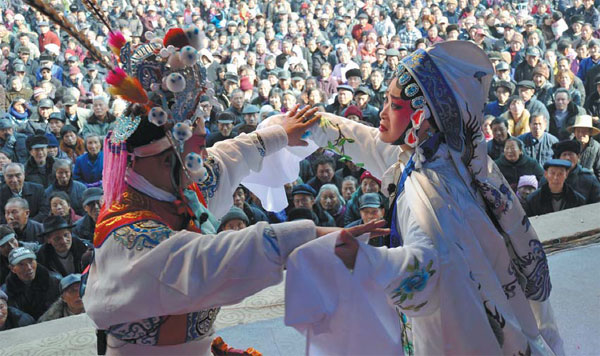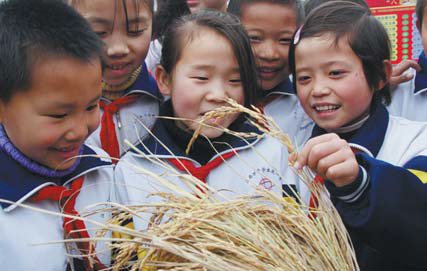Rice, china industries still going strong

Historical Jiangxi province remains a major national grain-growing region and global porcelain hub
Jiangxi has a long history and ancient civilization. In the Paleolithic Age, people worked the land in the region and planted wild rice.
In the late 1980s, archeologists found evidence of rice planting from 12,000 years ago in a karst cave in Wannian, Jiangxi province.
| A visitor looks at chinaware at the 2014 China Jingdezhen International Ceramic Fair. Jiangxi is known for its china. Zhang Wu / Xinhua |
| Jiangxi Opera is an intangible cultural heritage of Jiangxi province to be displayed at Expo Milano 2015. Zhu Dingwen / Xinhua |
| Primary school students learn about "Wannian Tribute Rice". An archaeological discovery found traces of rice-planting in Jiangxi 12,000 years ago. Zhuo Zhongwei / For China Daily |
| Tea farmers picking summer tea in Jiangxi's Wuyuan region, a renowned tea-producing area in China. Hu Dunhuang / For China Daily |
Before the finding in Jiangxi, the earliest evidence of rice planting in China was found in Hemudu, Zhejiang province, which indicated people started planting rice there 7,000 years ago.
The archaeological discovery in the 1980s shows that farmers in Jiangxi found wild rice, cultivated it, planted it and optimized it, forming a whole set of rice-planting culture.
The rice produced in Jiangxi is regarded as tribute grain to the imperial families over thousands of years in different dynasties.
A patch of wild rice crops in Dongxiang town of Wannian is thought to be the northernmost location of the original rice species in the world today. Historians say the discovery of this patch of wild rice provides evidence proving that the area around Ganjiang River and Poyang Lake is where rice originated. It also provides valuable biological samples for research on the origin of rice.
Farmers in Heqiao village, Wannian, plant a special rice variety called "Wannian Tribute Rice", which was originally known as Wuyuanzao. The nonglutinous rice developed over thousands of years and has a long growing period with a special flavor.
Zhu Yuanzhang, the founding emperor of the Ming Dynasty (1368-1644), ordered people to plant the rice for generations and use it to pay tribute to the imperial family every year. Wannian rice is known as one of the four rice types in China, along with rice produced in Jiangsu, Sichuan and Shaanxi.
Jiangxi remains one of China's main grain production bases south of the Yangtze River. The rice growing area accounts for 60 to 70 percent of the overall cultivated area in Jiangxi. Paddy fields cover 85 to 90 percent of the area planted with grains. The output of rice accounts for 95 percent of the grain yield in Jiangxi.
Rich China industry
As part of the "Jiangxi-themed day", which falls on Saturday at Expo Milano 2015, intangible cultural heritage items will be displayed. These will include Jiangxi Opera, china produced in Jingdezhen, lion dancing, tea art from Wuyuan, papercutting from Xingan, egg-carving from Anle county and handmade oiled paper umbrellas from Wuyuan.
Jiangxi is well known for its china industry. The "china road", which starts in Jingdezhen, was an important marine trade route for china, tea, spices and gold and silverware between China and Europe from the Tang Dynasty (AD 618-907) to the Qing Dynasty (1644-1911).
People in Jingdezhen started producing porcelain more than 1,800 years ago, and making china more than 1,600 years ago. The industry developed fast from the Song Dynasty (960-1279) and the city became a center of the china industry from the Ming Dynasty.
Jingdezhen has been a center for the china industry for nearly 2,000 years and it is known as the "capital of china". It boasts of a number of kilns from different dynasties that have special technologies, raw materials, designs and crafts.
Experts say that nowhere else in the world matches Jingdezhen in terms of its china industry and history. The china made in Jingdezhen is renowned for its quality, delicacy, color and design. China made in Jingdezhen is regarded as an important treasure in Chinese culture and is an art and symbol of the country.
Last year, overall production value of the porcelain and china industry in Jingdezhen was 29.16 billion yuan ($4.86 billion), an annual increase of 17 percent. Local porcelain and china enterprises focus on converging traditional crafts, modern arts and innovation.
Apart from handmade traditional porcelain and china products, new technology is another key factor that is promoting the development of higher-end porcelain and china in Jingdezhen.
The city welcomes international porcelain and china enterprises to cooperate with local kilns for research and development, production and marketing, to increase the added value of its economy.
Cultural heritage
Jiangxi Opera, another provincial folk art, is a historic performing art featuring different instruments, accents, voices and music. It originates from the convergence of two troupes from Raohe and Xinhe in 1950. The unified troupe entered Nanchang, the provincial capital, and ushered the art into a new development stage called Gan Opera, as Jiangxi is called Gan for short in Chinese. Gan Opera has had a great influence on many local operas in Beijing, Sichuan, Hunan and Shaanxi, and became an intangible national cultural heritage in 2011.
Lion dancing from Jinxi county, in Jiangxi province, is another influential performing art with a long history. Local people perform the dance during festivals.
In Wuyuan, almost every family in the countryside plants tea and many people work in tea-related businesses. The planting, processing, making and drinking of tea have evolved into a special tea art.
(China Daily European Weekly 07/17/2015 page15)
Today's Top News
- Japan tempting fate if it interferes in the situation of Taiwan Strait
- Stable trade ties benefit China, US
- Experts advocate increasing scope of BRI to include soft power sectors
- New engine powers cargo drone expansion
- China to boost green industry cooperation
- Manufacturing PMI rises in November


































